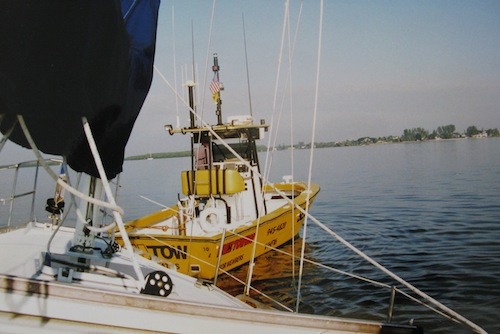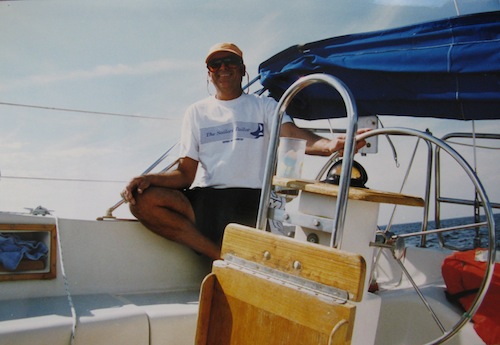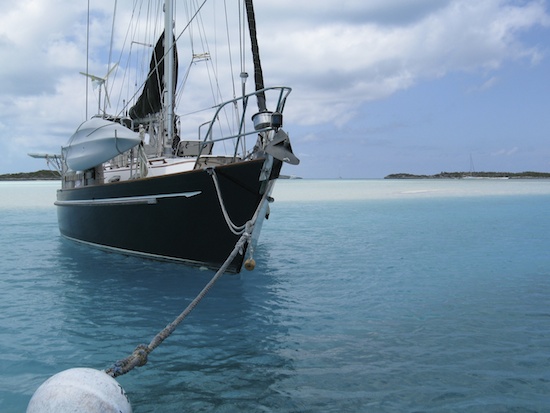Silence. No herons krawking in flight. No water rushing past the hull. No kamikaze pelicans diving for fish. No porpoises playing alongside. No apparent wind whining through the rigging. Even the diesel seemed muted. Somehow this was NOT how I had envisioned day one of our first solo cruising adventure.
(Note: This article originally appeared in Lats & Atts (now Cruising Outpost), March/April 1998.)
Looking west toward Sanibel Island, we could see an incredibly beautiful sunset over what should have been our first night’s anchorage. But we were going nowhere. We were aground just outside the channel on the Intercoastal Waterway (ICW) at low tide — just three hours into our initial charter cruising experience.
We knew what to do if we ran aground, but we had never read or heard many of the small details that probably would have kept us from running aground! Cruising is full of “things no one ever told you.” Experienced cruisers just know these things and sometimes don’t remember to tell the rest of us.
Upon arrival at the charter base, we were introduced to our floating home, allowed to stow gear and then invited to an extensive chart and boat briefing. During the chart briefing (conducted with the charter captain’s charts), it was casually mentioned that the charts on the boat might not be in quite as good condition as the charts we were looking at. This should have been our first clue to check the charts before we left the dock, but in our excitement, we shoved off — after all, it was getting late — 2:30 PM — and we wanted to be anchor down in our anchorage off Sanibel by 5 PM at the latest.

During our briefing, our charter captain showed us the depth sounder and told us not to be concerned until it reached three feet or even two and a half feet. What he didn’t mention was that in water under 10 feet, this depth sounder was not reliable. Sound waves bounce from the bottom back to the tranducer and in shallow water, they often become confused with fish, soft bottoms, bubbles from power craft – factors we knew nothing about. We did think it was rather peculiar that the depth sounder would go from 316 feet to 2 1/2 feet to 9 1/2 feet in the space of just a few seconds. Over the first hour of our cruise, the depth sounder bounced around so much we decided it was useless.
Suddenly we noticed the depth sounder go abruptly from 10 feet of water to less than 3 feet. We didn’t think too much about it since we’d seen it before. But this time, the boat abruptly stopped forward motion. For a few long seconds nothing happened, we tried to turn the boat toward the channel and depper water, tried to back off — all the things we’d read about, to no avail. At this point, we were afraid to keep the diesel running because it might be sucking up mud and sand. So we shut it down and threw out the anchor to keep us from drifting into even more shallow water.
During the chart briefing, the charter captain told us we’d either tell him we ran aground or we’d be lying. Well, obviously we weren’t going to have to lie!
We decided that our first course of action would be for high tide to float us off. We were only a few yards out of the channel, so it should be an easy matter. We grilled shrimp and almost enjoyed a little wine. Actually, this would have been one of our best anchorages, had it been an anchorage. We were anchored all alone under one of the starriest skies either of us had ever seen with multiple shooting stars adding to the atmosphere.
“High, high” tide was scheduled for the following morning at 9 AM. Somehow, I hadn’t envisioned spending the first night of our sailing adventure, “high and dry”. We turned on our anchor light and crawl into the V-berth to doze fitfully for a few hours.
At 4:11 AM, David jumps up with a start, looking out the hatch immediately above us. There’s a BIG barge bearing down on us! David ran to turn on the spreader lights to make us more visible. The barge’s search light shines over us a couple of times and David yells for me to get on deck “NOW”!!! After a narrow miss where the channel bends slightly, we turn on the diesel hoping the barge’s wake might be enough to lift us back to the channel, but no luck.
Later I asked David what exactly we were going to do if it looked like the barge might not clear us. His answer was that we were going to jump overboard. WHAT?? Maybe I’d just lost my sense of humor at this point, but I just don’t understand what good that would have done — and the thought of fleeing for my life running through a few feet of water evokes a somewhat surreal “horror movie” image.
Two more barges went though before dawn insuring that we didn’t doze any more. Still aground while the sun was rising, we were in no modd to appreciate what might have otherwise been a spectacular sunrise (or course, we normally would have been asleep and missed the sunrise …). Waiting for “high high” tide over coffee and a bagel, it begins to dawn on us that we were not going to float off this sandbar.
So finally, we got on Channel 16, identified our vessel and location and requested assistance. Turns out those trying to communicate with us can only hear about every third word. Not easy to let a towing service know you desire assistance when they can’t hear you. Since we could hear them, they finally asked us to key the mike twice if we wanted assistance. Sea Tow pulled us off the sandbar with bruised egos and a substantial amount lighter in cash.
(NOTE: Now we know, we might have kedged off using the anchor, but at the time, we didn’t even realize that was a technique … we knew how to sail and race sailboats, but didn’t realize there was so much to learn about a cruising boat!)
EVEN MORE IMPORTANT NOTE: Now we also know that we could have purchased towing services ahead of time — they cover the PERSON, not the BOAT, so any boat we were on would have been covered, even our charter boat. I think the $99 would have been a small investment against the almost $400 tow bill we ended up with — my advice, get either SeaTow, BoatUS or Vessel Assist towing insurance BEFORE you charter a boat if you’re in covered waters!)
















Seatow is more expensive, but worth it if you have a boat that might leave you broken down further than a 1/4 mile from your dock. BoatUS is only 99, and will tow you about a 1/4 mile before they start the clock on ya. Seatow I think is 199, but when my friends Morgan 44 engine went out, and we were three to five miles from the Sunshine Skyway Bridge in St.Pete, it would have cost him 1000 for the tow, but it cost him zero. I saw the bill too, there’s no hearsay with this. Also, the other thing you can do, is jump overboard with a small folding army shovel, and dig a trench underwater (yes, it can be done and that’s how everyone got off years and years ago), then throw / walk out the anchor, put pressure on it, and wait for pressure to ease. When it does, crank it some more. The other thing I’ve learned is not only rocking the boat, but you can put someone in a bosen’s chair on a halyard, hang over the side and push off. Or if you’re willing like I was, simply hold on and run off the deck like you did the first time you were in the BVIs and swung out away from the boat and plunged into the water. But, don’t let go. You will heel the boat over some and that might get you off. The other thing that I did last time, is I was lucky that the current was pushing us up onto the sand bank, and knowing that we were going only a couple of knots when we hit, I just cranked up the engine in reverse and sat there for a minute. It seemed like an eternity, but we were off within 3 to 5 minutes. One last tip. If you’re aground and you know you’re going to lay on your side, make sure there’s no large rock sitting there that you could have moved. And, if you have a dinghy, it’ll be time to drop it, put on the motor, crank it up, and use it too. I’ve seen many sailors successfully push the bow around pointing it into the desired direction, before starting to pull it off. Don’t forget to have the lifejackets ready too!
s/v Renasci